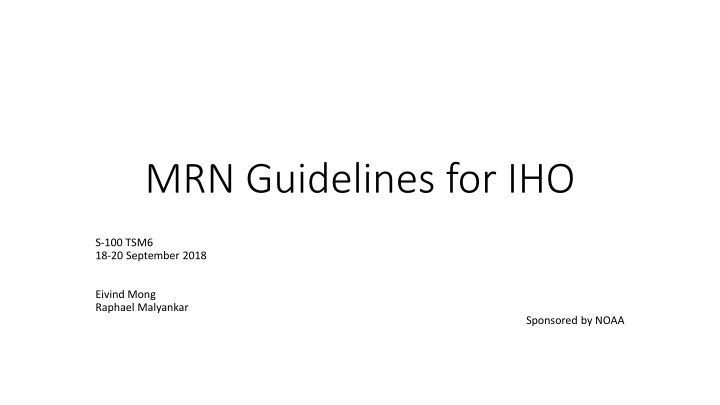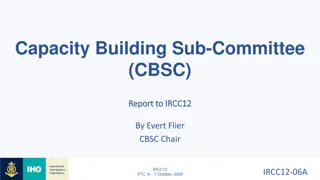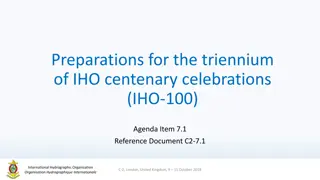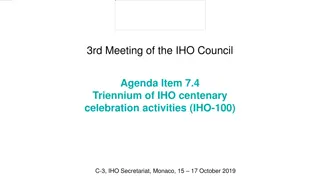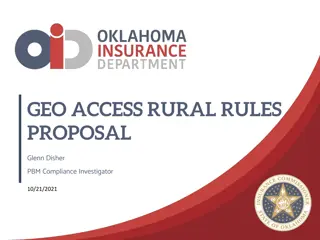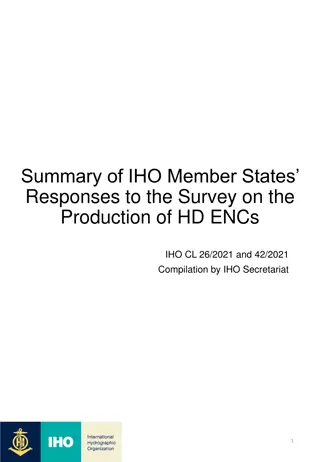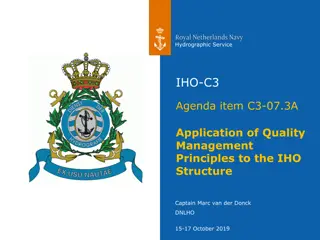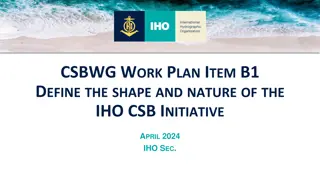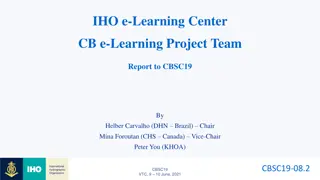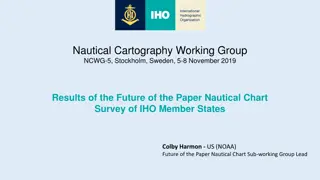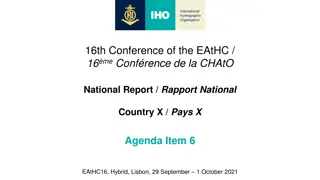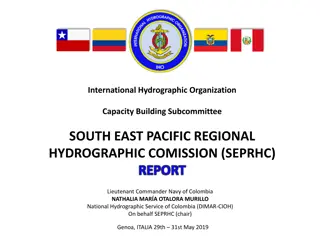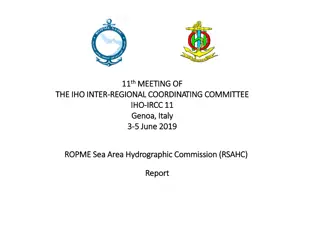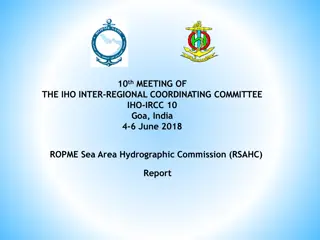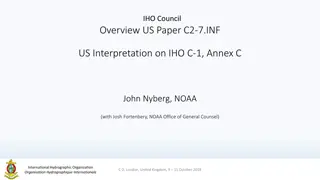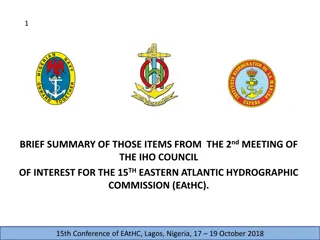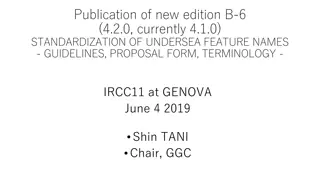Guidelines for Managing IHO MRNs - High-Level Rules and Recommendations
Establishing guidelines for the management of International Hydrographic Organization (IHO) Maritime Resource Names (MRNs), including rules for unique identifiers, length specifications, and preservation throughout the object's lifetime. Considers the governance, management, and allocation of MRNs at both IHO and Member State levels.
Download Presentation

Please find below an Image/Link to download the presentation.
The content on the website is provided AS IS for your information and personal use only. It may not be sold, licensed, or shared on other websites without obtaining consent from the author.If you encounter any issues during the download, it is possible that the publisher has removed the file from their server.
You are allowed to download the files provided on this website for personal or commercial use, subject to the condition that they are used lawfully. All files are the property of their respective owners.
The content on the website is provided AS IS for your information and personal use only. It may not be sold, licensed, or shared on other websites without obtaining consent from the author.
E N D
Presentation Transcript
MRN Guidelines for IHO S-100 TSM6 18-20 September 2018 Eivind Mong Raphael Malyankar Sponsored by NOAA
MRN Background Top level name space is urn:mrn IALA developed based on uniform resource identifier (URI) is defined in RFC 3986 (http://tools.ietf.org/html/rfc3986) Governed by IALA through mrnregistry.org MRN added to S-100 4.0.0 (3-10 & 11-7.4) as the recommended Globally Unique Identifier (GUID). IHO has been granted urn:mrn:iho, and should define management rules.
Two levels of guidance for IHO suggested IHO level Applies to all of IHO, e.g. publications, standards, products and the Member State level. Specific guidance included. Member State level Applies to solely to Member State level. Should be general guidance to permit Member States to adopt to their specific needs.
IHO Level guidance Governing body needed for the management of the IHO MRN domain Suggested to be done in a similar way as S-62, with the IHO Secretariat managing the domain on behalf of IHO. Public location (e.g. IHO website or GI Registry) for publishing the designated MRN namespaces should be set up.
IHO Level guidance high level rules Establish ranges of reserved codes, such as producer codes, and other codes (product, publication, etc.). For use during development of specifications (S100, S101, etc.). For example, JS00 should be a reserved producer code for Jussland test datasets. Producer codes should follow the recommendation given in S-100WG3-6.4
IHO Level guidance high level rules MRN specification gives no limit to the length of a MRN. Length of an MRN adds to the byte size of a dataset, and longer MRNs add more than shorter ones. The urn:mrn:iho part is 11 bytes, and additional characters will add one byte per character, per instance. Some flexibility may be useful in the length to give sufficient space to give enough space for different cataloging purposes. Recommended that maximum length of IHO MRN should 128 bytes.
IHO Level guidance high level rules MRN GUIDs should be preserved throughout an object s lifetime. Including when objects are reused in new products. For traceability source of an object. Enable user systems to link instances of the same object across products. Whether one data object is the same as another can be complex. Different data products or different versions of the same product may add or remove attributes, Coordinates may be different at different scales the number of points in a curve, surface boundary, multipoint grid may be different resolution spatial primitive may change as scale increases or decreases feature geometries may be merged at some scale Need guidance to help producers decide
IHO Level guidance IHO Publications For IHO Publications it will be useful to have a namespace for publications, followed by a few distinguishing characteristics for the individual publication to aid in distinguishability, and to make the MRN ID globally unique. Proposing this format of the Publications MRN: urn:mrn:iho:pub:<publication type>:<publication name or number>:<edition number>:<correction number>:<clarification number>:<optional and additional version information> <pub> a fixed namespace for publications. <optional and additional version information> can be used for additional name spaces as per need. IHO s current publication types and proposed codes for these are; Bathymetric Publications - bathy; Capacity Building Publications - cb; Miscellaneous (Base Regulatory Publications) - reg; Periodic Publications - per; Standards and Specifications - spec. For example S-57 with supplement 3 can be given the following MRN identifier; urn:mrn:iho:pub:spec:s57:3:1:supplement3
IHO Level guidance IHO Data Products For IHO data products it will be useful to have a namespace that clearly reveal that the MRN is about products. Proposing this format of the Products MRN urn:mrn:iho:prod:<product name>:<edition number>:<correction number>:<clarification number>:<optional information about related specification> <prod> is a fixed namespace for products, and means that any part of the identifier that comes after indicate the type and name of the IHO product. <optional information about related specification> can be used for additional name spaces as per need. Example for S-64 ENC test dataset version 3.0.1, unencrypted used for the power up check the ID could be: urn:mrn:iho:prod:s64tds:3:0:1:unencrypted:powerup Example for IHO INT3 version 3.5, Lowesmouth to Port Rimon panel, the ID could be; urn:mrn:iho:prod:int3:3:5:19000 A public location for listing the MRN for the IHO product specifications should be established. The MRN for the product specification should be included in the specification.
IHO Level guidance Object instances Structure Propose common structure for all MRN identifiers for object instances. Predicable ID structure can be leveraged for reducing total data volume. Proposing this format of MRN for object instances; urn:mrn:iho:<product specification>:<producer code>:<producer governed namespaces> This format gives a consistent structure across product specifications. Greater harmonization. Makes more of the upper level GUID namespace predictable. Data producers have flexibility over how they wish to manage their namespaces. Clear delineation between the fixed upper level and flexible lower level.
IHO Level guidance Object instances Byte saving options Fixed structure for each product specification (urn:mrn:iho:s :CCYY: - is the product specification number, CCYY is the S- 62 code pending change as per S-100WG3-6.4) Predictability of the fixed part of the GUID enables byte saving schemes, such as storing the fixed part in metadata. All producers need to use the same rules (same as with ENC FOID today). Rules must be included in the specification as a required structure. Function for recreating GUIDs may be needed in user and production software. Need rules for how to preserve GUIDs of objects that originate in other domains for example checks can see that if GUID start with MRN the origin is elsewhere, and all other cases the GUID should begin with the <producer code>. The same rules can also be configured with a list of permitted MRN name spaces to ensure that only permitted inputs are used and help identify erroneous MRN. Checks can be designed to look for permitted sources and flag all cases that do not meet the condition.
IHO Level guidance Object instances Challenges with GML Important considerations The URN format cannot be used for values of the built-in XML Schema type ID The gml:id attribute in GML 3.2.1 is of this datatype. It is mandatory in GML 3.2.1 and is used by associations. The ID datatype is what XML provides to identify chunks of XML. It can t be ignored. The : character in an XML tag (including tags in GML) is reserved for separating namespaces from local names . MRNs should not be used verbatim for GML identifiers ( gml:id ) or tags (in any XML data format, including GML). Datasets that try to use MRNs verbatim for gml:id s or in tags will fail schema validation. MRNs can be used as values for an identifier attribute, or the product specification define a rule for mapping MRNs to gml:id values.
IHO Level guidance Object instances Rules for preservation of MRN Proposed rules for deciding if the MRN of an object should be preserved product specification authors should include guidance for data producers on how to determine how similar instances are to the original. Suggest these points as a start of such guidance Classes whose attributes are subsets of the original object class attributes should be considered the same and their instances should have the MRN preserved. When adding attributes, consideration should be given to intent of the object, and as long as it is to describe the same physical phenomenon and the instance uses the original feature as a starting point, the ID should be preserved. Objects that are generally considered scale independent, and preserved in the same location and with the same shape through scales and products should retain the same MRN ID in those products. Scaled objects need not be considered as the same object between scales.
IHO Level guidance Object instances Rules for preservation of MRN Leaving the decision of what are same instance completely to data producers may lead to inconsistencies within the same data product. There should be some guidelines for data producers to follow. Product specification teams should determine the guidelines. Best place for the guidelines is the individual product specification.
IHO Level guidance Future considerations Some management challenges remain to be addressed. An example is the current GI Registry which has the camelCase ID as a GUID for feature concepts in all domains. Uncertainty of which MRN structure can manage this. Ideally be a common harmonized structure for the GI registry as a whole. Would submitters use the IHO namespace, or use their own name spaces (e.g., IALA). How to structure MRN for different domains. Harmonization could become an issue. MRN format should take into consideration whether mapping of an MRN to a URL may be needed in the future, for example to facilitate lookup of additional information, metadata, or updates to a data object. See S-100 11-7.4 and TSMAD26/DIPWG5_11.7E for more information and hypothetical use cases. Consider giving all organizations with an S-62 ID, an OSNID that match the S-62 ID. Enables a link between S-62 and producers of data Recommend that there is no automated creation of S-62-linked OSNID in order to clean up the content of S-62. Linking to S-62 codes permits organizational name change without needing a code change.
Member State level guidance Intended for producer organizations that generate data in compliance with IHO product specifications. Namespace owners should develop a guideline for managing their name spaces. Consider the following paragraphs a draft guideline that provide the starting point for implemented guidelines. Recommend maximum total length should be no more than 128 bytes Upper level name spaces (urn:mrn:iho:s :CCYY:) takes 22 bytes. Up to 106 bytes/characters ( characters include colon) for producer governed namespaces. Shorter MRN reduce file sizes of products. It may be advantageous for some producers to subdivide MRN IDs. more than one office/contractors produce data in a particular domain inside one. IDs can be subdivided at a national level by provinces, by projects or by topics where a specification contains several topics, such as ENC. The data production process should include functions to preserve MRN IDs from original source to all derived products, as far as possible. Consider the intent of objects, if the purpose is to describe the same physical phenomenon, the ID should be preserved. If the instance use the original feature as a starting point, the ID should be preserved. It is not necessary (but not prohibited) to preserve the MRN of scale dependent features.
Examples of how a GUID from another domain may look among other product producer generated MRN IDs; Feature: Recommended Track Attribute: category of recommended track: Based on a system of fixed marks Attribute: orientation: 270 degrees Attribute: MRN: urn:mrn:iho:s101:jsho:12345678 Feature: Navigational Line Attribute: category of navigation line: leading line bearing a recommended track Attribute: orientation: 270 degrees Attribute: MRN: urn:mrn:iho:s101:jsho:87654321 Feature: Landmark Attribute: category of landmark: tower Attribute: function: light support Attribute: MRN: urn:mrn:iala:s201:jscg:54321678 Feature: Light Attribute: category of light: leading light Attribute: colour: white Attribute: MRN: urn:mrn:iala:s201:jscg:45678123 Feature: Range System Attribute: name: Micklefirth approach range Attribute MRN: urn:mrn:iho:s101:jsho:23456781 Aggregation: Range System Aggregation Consists of: MRN: urn:mrn:iho:s101:jsho:12345678 Consists of: MRN: urn:mrn:iho:s101:jsho:87654321 Consists of: MRN: urn:mrn:iala:s201:jscg:54321678 Consists of: MRN: urn:mrn:iala:s201:jscg:45678123 Doubling Point Range Lights on NOAA chart 13296. (Image from Wikipedia.com)
